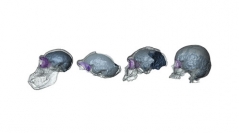

 Comptes Rendus Palevol
16 (5-6) - Pages 499-507
Comptes Rendus Palevol
16 (5-6) - Pages 499-507The evolution of the frontal lobes represents a major issue in paleoneurology. In this survey, we used a surface analysis to describe the frontal morphology of three relevant East African specimens from early and middle Pleistocene: OH 9, UA 31, and Bodo. When compared with a modern human endocast, UA 31 and Bodo display a flatter dorso-lateral surface, while OH 9 shows a general flattening of the whole dorsal morphology. OH 9 is the specimen with older chronology and with orbits more separated from the prefrontal cortex than in UA 31 and Bodo. The morphology of these three specimens is in agreement with the hypothesis that increase of the frontal curvature is due to the shifting of the facial block under the anterior cranial fossa. Apart from variations in size and general proportions, surface analysis can be useful in analyzing morphological changes localized in specific cortical areas. The three fossils are used as case study to discuss and review some relevant issues concerning frontal lobe evolution and paleoneurology.
Human evolution, Paleoneurology, Prefrontal cortex, Anterior cranial fossa, Endocasts, Deformation-based models